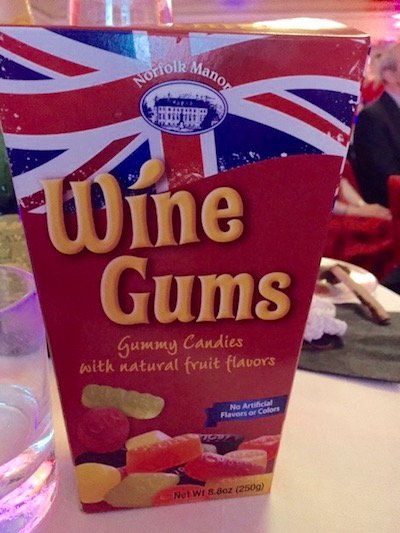BRIT WEEK 2016: Top English Foods to Try


The food stakes were high at the BRIT WEEK (www.britweek.org) 2016 10th Anniversary Gala following a formal tea only days before prepared by the charismatic, Chef Darren McGrady, former private chef to Princess Diana and the Princes. Simpson’s Spotted Dick tins, jars of Seville Orange Marmalade, Stockley’s Milk Chocolate Bars, and boxed Shortbread were piled high on display tables on the lawn of the at the Fairmont Hotel overlooking the Pacific Ocean,

Spotted dick, British pudding made with suet is dotted with dried fruit plus currants and/or raisins is often served with a custard, perhaps because the cake itself is very dense. We found the tinned version we heated up to be spongy in a pleasant way, although we didn’t realized to just “spot” the top of the tin with punctures and instead took it off with a can opener, then laid the top over while cooking in water brought to a boil and then a simmer. When prepared from scratch at home, the flat sheet of suet pastry is sprinkled with dried fruit, then rolled up into a circular pudding.
The first reference to Spotted dick is in Alex Soyer’s, The modern Housewife (1849). The author writes directions for “Plum Bolster, or Spotted Dick.” In this case it begins with, “Roll out two pounds of paste … have some Smyrna raisins well washed…”. The Pall Mall Gazette in 1892 reported that “the Kilburn Sisters … daily satisfied hundreds of dockers with soup and Spotted Dick.”
The name has long been a source of amusement and double entendres, to the point that the relatively influential catering staff of Flintshire County Council decided in 2009 to rename it, “Spotted Richard” because of all the jokes they were receiving. This did not happen. They were not quite powerful enough to make this new name stick (excuse the pun). In any case, the term “spotted” is a clear reference to the dried fruit in the pudding, which resemble spots. “Dick” is more obscure although the term was widely used as a term for pudding in the 19th century. Another possibility is that it is a corruption of “dough”.
Sticky Toffee Pudding, moist sponge cake stuffed with raisins or dates drenched in a toffee sauce, originated in Scotland. It too is usually served with custard or ice cream. London’s most famous is at The Queens Arms, Kensington [www.thequeensarmskensington.co.uk ] or The Holly Bush, Hampstead [www.hollybushhampstead.co.uk]
Though all the desserts were sweet, they were pleasantly so with no craving afterward in the way American sweets have a tendency to do. Perhaps the good cheer in this case was due to the festive atmosphere and the giddiness from cocktails served with entertainment before the lawn party, even the Wine Gums tasted good! Or was it because the of the candy’s “natural fruit flavors”? As with most British chocolate, however, the bars tasted a bit chalky.

Only days before, Chef Darren McGrady previewed the British Royal Family’s favorite desserts at a formal high tea, down to the beloved birthday cake in service since Queen Victoria. Queen Elizabeth’s personal favorite, the biscuit cake was also on the table. At the Gala, the cakes were presented in the form of small patties and the custard in huge half pans, cut before the guests at a food station. Both recipes are in his cookbooks.
 Chef McGrady was personal chef to the late Princess Diana and the Princes. Chef McGrady, now a US citizen all excited to vote, owns and operates a thriving catering business in Houston, Texas. What could be more American than that?
Chef McGrady was personal chef to the late Princess Diana and the Princes. Chef McGrady, now a US citizen all excited to vote, owns and operates a thriving catering business in Houston, Texas. What could be more American than that?


Below is the family’s even more beloved biscuit cake. Chef McGrady laughed at the memory of the very serious Queen Elizabeth’s delight with the cake. No matter what was on the menu at the palace for dessert, Queen Elizabeth would cross out a dessert and write, “biscuit cake” in place of it. At formal gatherings, once the queen took a polite forkful bite or two of the cake, it would be replaced with a whole fresh slice at the table for her — which she loved, chuckled McGrady. I mentioned to him when hearing him retell the story that he was exuberant with it the second time I heard it, I’d bet he was the same way after 100 times. “One thousand times,” he chided me with a grin.
The ultimate British tradition, afternoon tea is a leisurely affair with finger sandwiches, scones with jam and cream, pastries and choice of tea. These days a glass of champagne as well, replacing the sherry that once seemed to help the name, “high tea.” In Los Angeles, our favorite, summer or winter, is in the polo lounge at the Beverly Hills Hotel. Ojai’s Main Street up the central coast used to have a tea shoppe with more than leisurely high tea. When it was well over 100-degrees (and it often was in the summer), it was so hot and dry outside that time seemed to stop. When in London, Fortnum & Mason’s Diamond Jubilee Tea Salon, Piccadilly, is known to have the best when in town. [www.fortnumandmason.com]
Fish & Chips brought out the Liverpool accent of Mark Ballas (Dancing with the Stars), who was even more engaging and lively than on the show itself. Fish & chips is traditionally eaten with mushy peas and garnished with salt and vinegar. When in England, Poppy’s, Shoreditch or Camden is highly recommended. [www.poppiesfishandchips].






 Gerry Furth-Sides
Gerry Furth-Sides  Barbara Hansen
Barbara Hansen  Chef-owner Alain Cohen
Chef-owner Alain Cohen  Roberta Deen
Roberta Deen  Jose Martinez
Jose Martinez  Nivedita Basu
Nivedita Basu